Reflections from Red Badger's 2025 Partner Day
Dive into Red Badger's Latest Annual Partner Day and learn how alignment, strategic hires, and client trust are central to how we're creating shared...
This Earth Day, we've taken a look at how the circular economy and digital technology can help tackle the climate crisis.
This Earth Day, in this second article in a 2-part series we tasked ourselves with looking at how digital products and technologies can help fix a complex problem like climate change by accelerating us towards a circular economy.
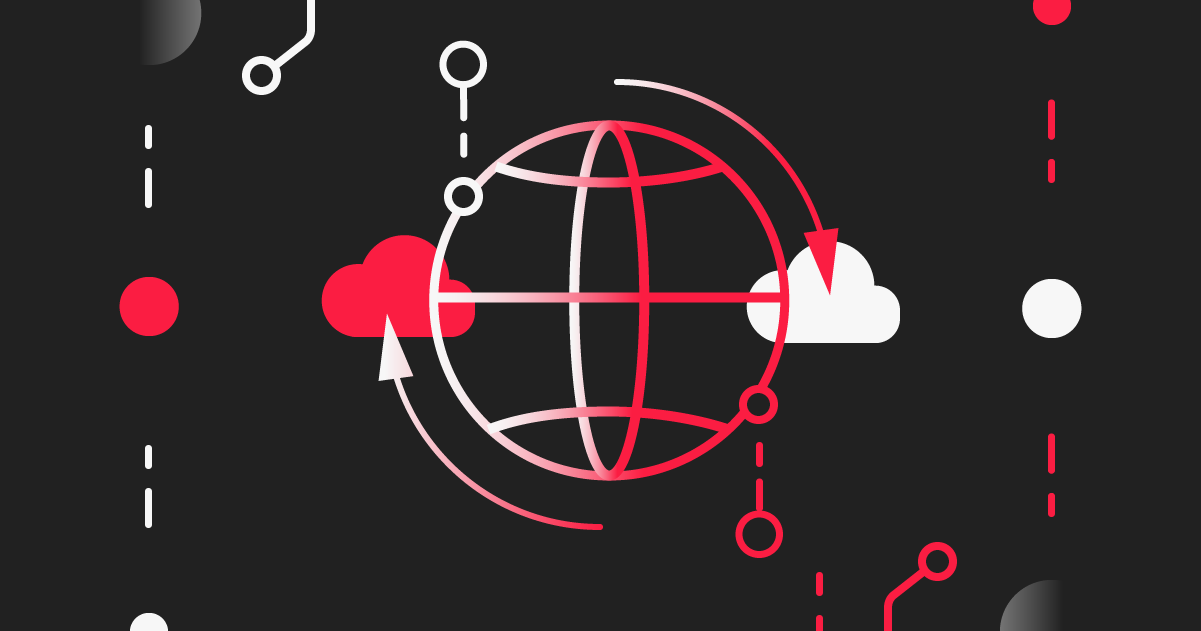
If you haven't already, make sure you read part one, where we talk about how we have made a few mistakes on the way similar to when building digital products.
No one person, organisation, manufacturer, government or country can solve a complex challenge like climate change by themselves.
It needs to be a joint effort where we balance eliminating negative impacts including greenhouse emissions while maintaining the harmony in the systems, structures, and markets that ultimately make the modern world we live in (and enjoy) function.
You wouldn’t be wrong in thinking maybe it’s just too big, too complex to solve and say this all sounds quite daunting.
We need a rethink of our approach and to embrace circular thinking and a circular economy with digital product thinking. It will require bringing together different expertise and experiences like working in cross-functional teams.
Now is the time to change and evaluate alternatives.
The Ellen MacArthur Foundation (EMF) is a charity Dame Ellen set up after sailing around the world and learning the power of circular thinking. Its mission is to accelerate us towards a circular economy.
A circular economy is about getting the most value out of the resources we have, keeping them at their highest utility and value.
This article will reference the circular economy regularly so a base level of knowledge will be beneficial. Here is a great video describing the circular economy.
The circular economy is based on three principles:
Principle 1 - Eliminate waste and pollution
Principle 2 - Circulate products and materials (at their highest value)
Principle 3 - Regenerate nature
A reframe of our mindset is needed where we must visualise development and delivery through a complete cycle - just like we do with digital products.
The butterfly diagram explained here is a powerful way of visualising the circular economy.
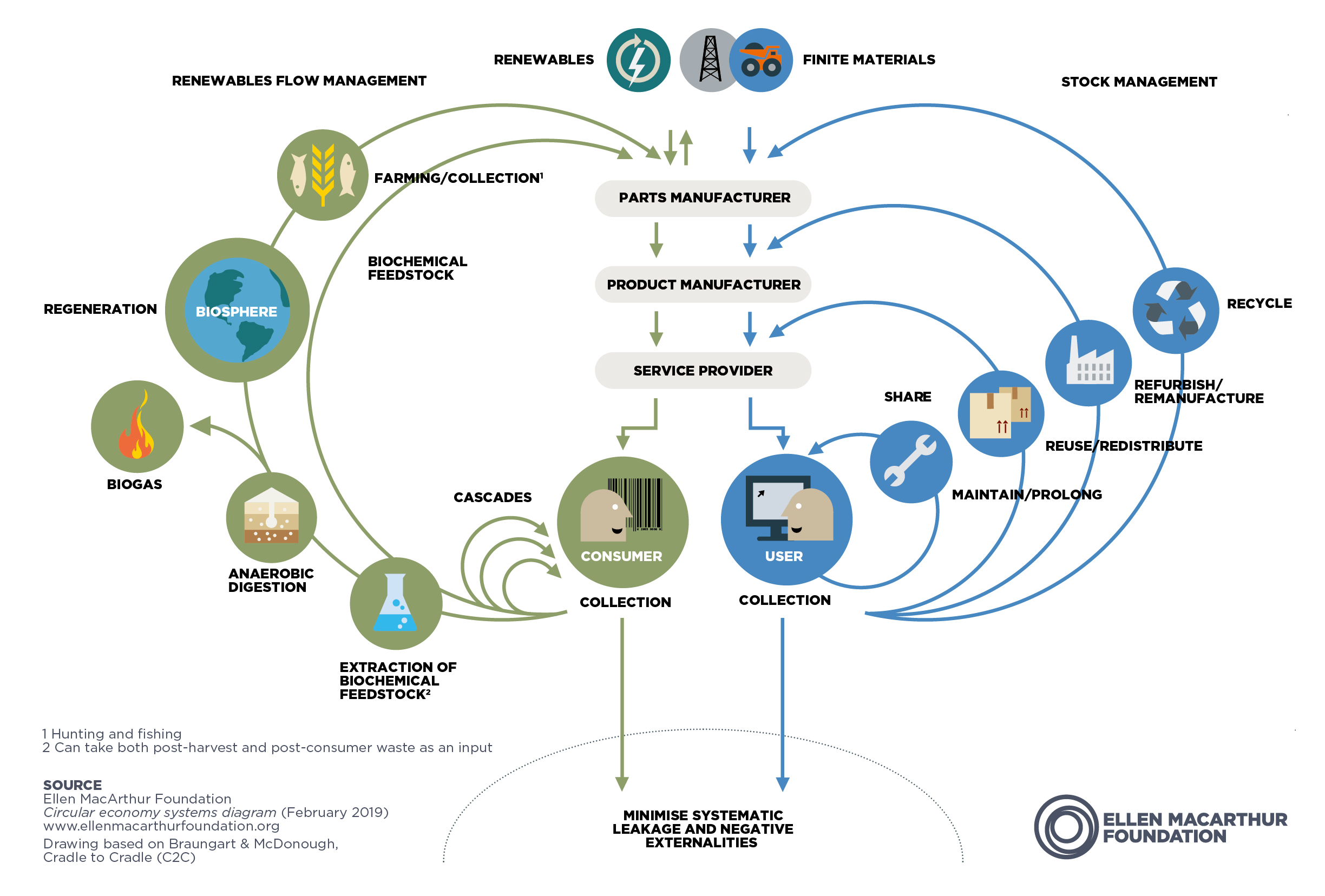
In a circular economy, design is never done.
Design considerations are much wider and look at everything from who extracts, builds and disposes of things as well as who uses them and even the systems they make up, tapping into more than just recycling materials.
Zooming out from the end-user to consider the wider network opens new opportunities. If we can extend the useful life of products we slow down the pace they are put through recycling loops or even eliminate them entirely.
Similarly zooming out (and back in) when conducting user research in discovery projects allows dots to be connected.
A deeper examination of internal organisational processes often highlights where a back-end function can create significant improvements for a customer with minimal disruption to the organisation.
An example of a well-thought design for longevity is Vitsoe which makes long-living furniture, inspired by Dieter Rams and his principles for good design.
Designing furniture and striving to be better rather than simply newer, clearly leaning on the six design strategies for longer-lasting products.
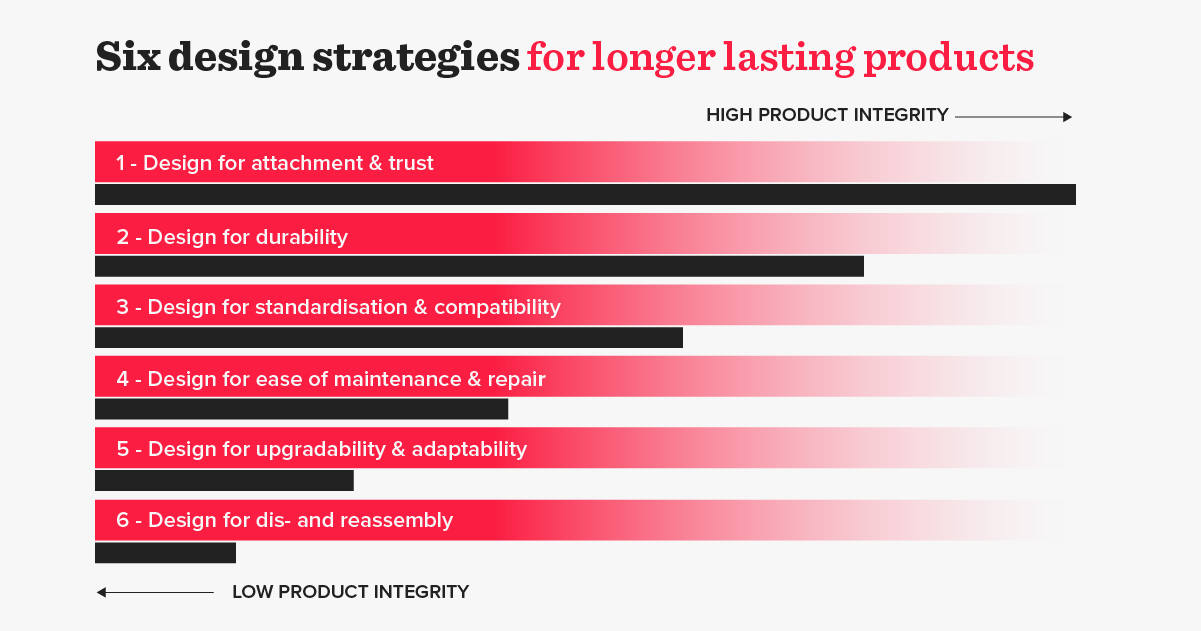
Designing digital products taps into these same strategies, making use of atomic methodology, design systems and reusable patterns to ensure users don’t have to learn new behaviours when interacting with interfaces.
We see many individual products with a sustainable focus trying to solve a particular problem and do good.
It is certainly a step in the right direction and giving consumers choice is the first step.
But this does not guarantee success and avoid us from falling into the trap of owning a single life product instead of single-use, which is only a minor upgrade.
Chilly's offers reusable cups and bottles for drinks, and metallic vessels with aesthetic coatings. These are very difficult to separate from each other when it comes to recycling, so even if it is used 10,000 times we still have challenges in reusing the materials and it could still end up as waste.
Wild provides natural deodorant in a recycled case. The casings are made from separate recycled materials but assembled using solvents like glues, which devalue the individual materials by making them hard to separate.
Who gives a crap sells toilet rolls made from bamboo. While bamboo is seen as a more sustainable solution, it can have a significant carbon footprint (most originates from China) with related logistical or shipping costs. And growing large volumes of single vegetation like bamboo impacts local ecosystems–similar to the challenges being felt from the proliferation of palm tree plantations.
Profitable circular businesses that minimise waste and environmental impact have successfully closed the loop in the circular economy.
With near-total eradication of waste and an end-to-end lifecycle consideration of the products they produce, these organisations are the embodiment of a digital product focus in the business world.
Digital products see organisations align around product delivery, relentlessly focused on innovation aligned completely with customer demand.
It sees total commitment from an organisation to only create what they know is valuable - to both the business and customers. This approach focuses teams (and the wider business) on the responsibility to its purpose and mitigating all forms of waste.
Shifting to a digital product mindset and product thinking helps not only create a more sustainable business but attracts digital talent too.
Expertise like UX designers, product managers or software engineers want to work for organisations that are purposeful and environmentally conscious.
Today's global supply chain thinking means factors like labour costs drive production.
Each part of the process can span geographic locations, maximising resources at each location and driving production costs down, but with little consideration of the impact on the environment.
Complex logistics are ultimately then more risky, prone to fluctuating economic factors or environmental disasters and produce more emissions.
Technology affords us new opportunities to re-distribute manufacturing (RdM) and solve many of the broader challenges associated with largescale supply chains.
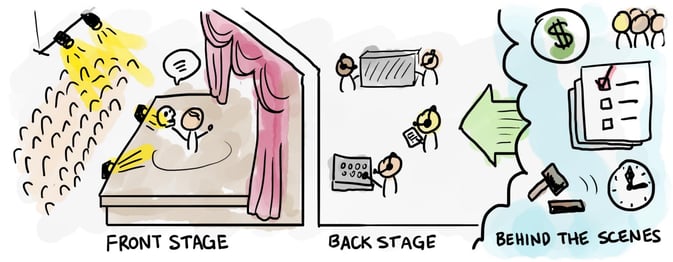
Getting your behind the scenes in order by service blueprinting to understand what is happening is just as important as the backstage and frontstage when delivering digital products.
That’s exactly where a circular supply chain sits.
Instead of a disjointed flow of information–similar to siloed teams–when organisations are building and delivering a digital product it shares data and communicates critical information at all stages to change the current production in real time.
Digital has the potential to change our economy to a circular one and accelerate us towards it more quickly in almost unimaginable ways.
Truthfully, it’s hard to see the shift to a circular economy without the application of new and exciting technologies and considering new, innovative and next-generation ideas.
Circular ideas that leverage multiple types of technology are some of the best solutions available to us today, combining their use to create extraordinary and amplified results.
As explained in part 1, a fully electric car (that produces zero emissions) compared to a diesel car only reduces its overall CO₂ impact by half due to the (finite) materials used in its production.
The same can be said for mobile phones, the biggest environmental impact is making the thing in the first place.
If we are designing products better so they last longer with replaceable and refurbished parts, we are going to need ways to track which parts are in which products and for how long.
This thinking could be applied to the automotive industry with many companies exploring the idea of retaining ownership of the physical vehicle itself while leasing to consumers long term over a number of years.
Asset tracking could allow for this without throwing out or losing high-value components by making customisability and upgradability to the latest tech part of the service offering.
A great example of this is fairphone, where you get a durable mobile phone you use for as long as possible through extended software support.
The Fairphone model creates benefits for all:
Consumer - allowing easy access to maintenance services
Manufacturers - gaining insights into the use of their devices
Industry - showing what’s possible, increasing demand for sustainable options and inspiring the industry to behave more responsibly
Digital product thinking can open up new business models such as subscription services.
Honestly though, if you create a great user experience and offer real convenience as part of your digital product offering the shift will happen naturally from users without being forced.
Think about Spotify or Netflix, previously we all owned shelves full of physical CDs and DVDs that had been manufactured, transported and sold in physical stores.
Today it’s all available via our smartphones or TVs and stored in the cloud.
Technology has also given birth to the sharing economy, allowing private individuals to easily share assets and services with each other.
Great digital products made this easy for users. For example, Airbnb helps homeowners maximise empty space within their homes and offers bespoke stays for travellers instead of often expensive hotel rooms.
Zipcar provides vehicles as a utility, reducing ownership of motorised vehicles and providing affordable rental of electric vehicles in cities.
This is a much more cost-effective and efficient model - particularly for travellers or people who don’t need to drive that much. It also is a great way to reduce some congestion in our urban areas and free up precious parking spaces for visitors.
Even small incremental changes can help an organisation move towards being more circular.
For example, we helped Nandos reduce the need for physical cards by working with them to build and deliver the first NFC-enabled, contactless loyalty card.
Data is a game-changer when it comes to circular innovation and building upon other technologies to surface better solutions for users.
Think of the examples already mentioned and consider how data could predict more accurately when replacement parts are likely due as part of maintenance services of modular products of the future.
Or like how Spotify and Netflix tailor content they recommend to us based on previous listening/viewing sessions.
Data can also help behind the scenes, as outlined beautifully here in a product example imagining the future of the toothbrush.
A new circular supply chain where information is shared between all entities, feeding back user information from the smart toothbrush to inform on dental habits, offer incentives to the user and promote good dental hygiene.
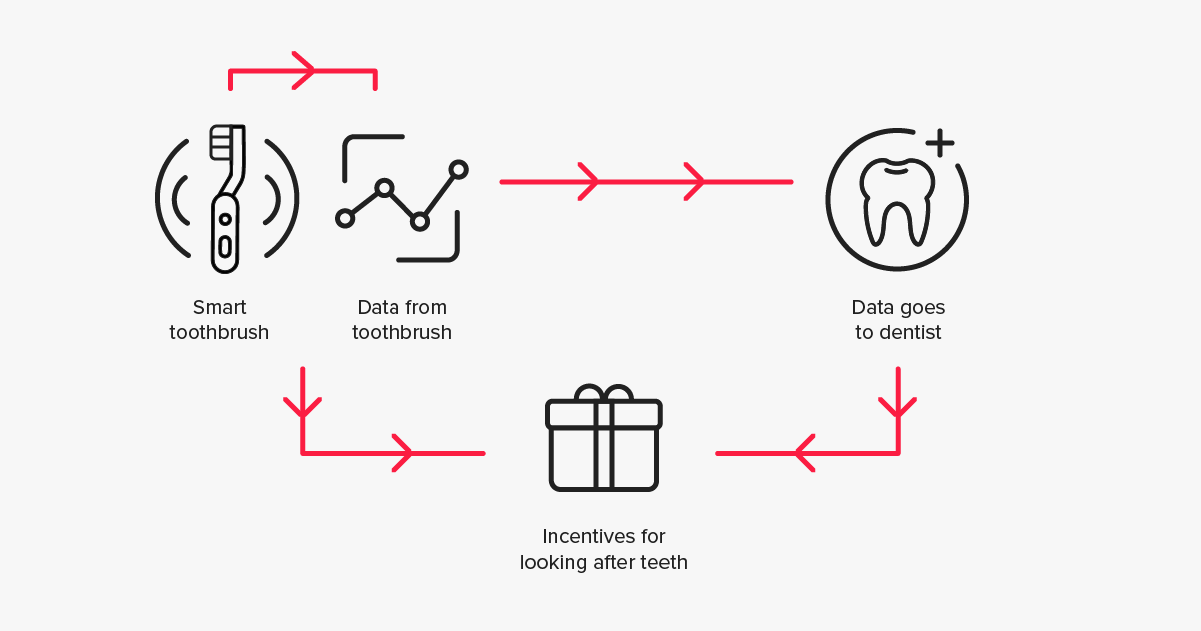
The first principle of the circular economy is to reduce waste (or even better, turn one’s waste into another's resource).
This guiding principle helps to maintain the flow of materials or even capture materials for reuse within industries. Some companies have used artificial intelligence to achieve just that:
The triple bottom line is a business framework that asks key questions rather than just referring to the ‘profit’ or ‘loss’ of an organisation and translates excellently when talking about the benefits of a circular economy.
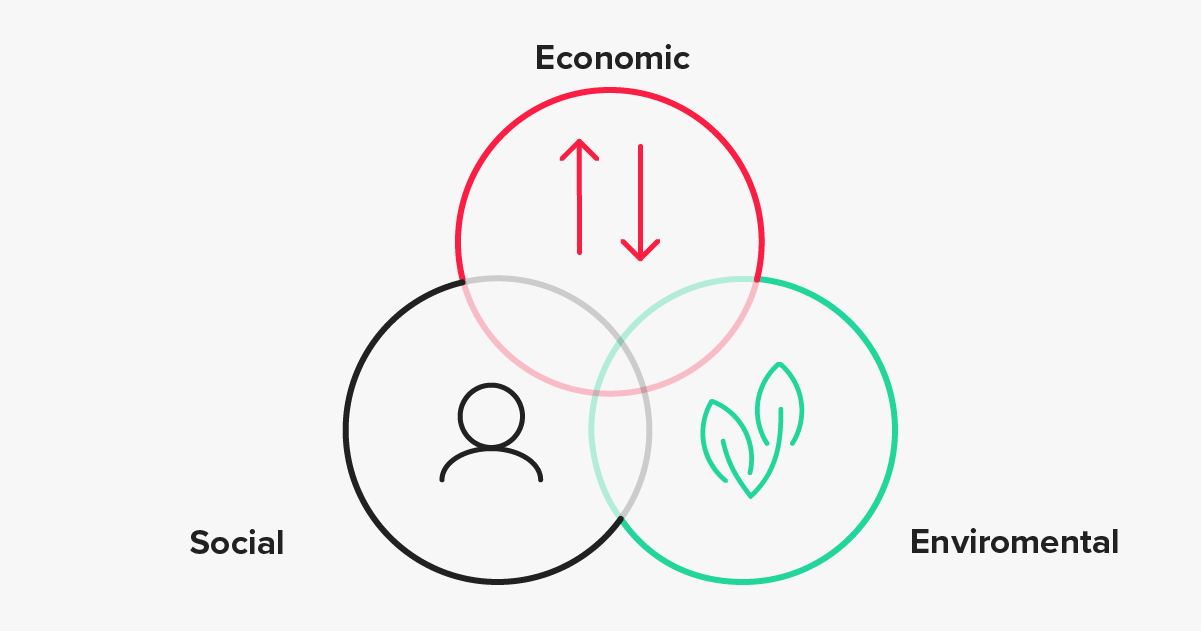
As a species, we have made enormous progress over such a short time.
If we want to continue on this trajectory and keep tackling (and succeeding for the most part) complex problems like reducing poverty or giving the opportunity for everyone to access education and creating a fairer world, we have to keep thinking about how to do things better.
You could say the sky's the limit but why stop there?
If we as a society can support ourselves indefinitely in a system and economy as our planet earth allows, with the rate of technological advancements in space travel we could go on to colonise different and new worlds light-years away.
Our home continues its perfect balance that has allowed us to prosper and become the first species we know of to have dominated a planet.
As scientists call it, the Holocene era has been one of the most stable periods in our planet's history. For 10,000 years our climate has had extreme continuity, the average temperature has not wavered up or down by more than one-degree celsius.
The consistent climate and rhythm of seasons have led to agriculture, building civilisations and sharing knowledge like never before.
For businesses, the ability to reduce risk provides a huge advantage over competitors.
The volatility relating to access to resource materials was highlighted recently with aluminium costs increasing 30% to a record high because of the conflict between Russia and Ukraine threatening supplies.
We need to teach the principles of circularity as part of education, in schools and universities to create the next generation of circular thinkers.
It won’t be easy but as Sir David Attenborough stated at COP26, we are the best problem solvers to have ever graced this earth.
Advancements in digital technologies create new approaches to business. Renewable energies make traditional energy resources like coal phase-out of fashion.
We are already seeing trends emerge such as domestic CO₂ output reductions for some high-income countries while not negatively impacting GDP growth. The shift is already happening.
The circular economy needs to be seen as an opportunity because that’s exactly what it is. If you don’t shift your thinking, behaviour, organisation's offer–or all the above–chances are one of your competitors will.
Resources
I have included some resources if you want more information or are ready to take the next step on your journey to becoming more circular.
Dive into Red Badger's Latest Annual Partner Day and learn how alignment, strategic hires, and client trust are central to how we're creating shared...
Discover five key lessons from implementing OpenTelemetry in micro services.
Larger businesses that partner with top-tier digital consultancies drive better customer experience through innovative, quality-focused approaches...
Add a Comment: